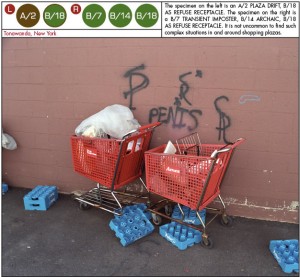Driving east on Cumings Street, there is almost always a shopping card wedged into a bush, resting beneath a tree, or rolling 30 mph towards the Bag and Save parking lot. It always got me thinking about how this area just wouldn’t be the same without these “icons” of the hood making their presence known.
It reminded me of a website that I visited a few years ago that is since going strong. The Stray Cart Shopping Project. http://www.strayshoppingcart.com/shopping_cart/1_introduction.htm
Julian Montague is an artist based out of Buffalo, NY and designed this system of classification that allows stray shopping cards to be identified based on the situations where they are found.
There are True Strays: ones that left a parking lot and gone into the world; and False Strays: ones that have stayed close to their source. He has identified nine sub-categories of false strays and 21 sub-categories of true strays, all of which are documented with photo examples. Montague feels that this kind of classification system serves as a kind of vector for looking at the social makeup of a place. (Vandalism is also a good indicator.)
“Over the last several decades, the stray shopping cart has quietly become an integral part of the urban and suburban landscapes of the industrialized world. To the average person, the stray shopping cart is most often thought of as a signifier of urban blight or as an indicator of a consumer society gone too far. Unfortunately, the acceptance of these oversimplified designations has discouraged any serious examination of the stray shopping cart phenomenon.”
It is a well designed website that definitely has Montague’s aesthetic, and it is a truly interesting and refreshingly NEW and different way to look at our urban landscape and class system. I would visit this site for the photography alone.
Rusted shopping cards smashed into the sides of buildings (damaged at source carts), a wheel poking up out of a hill of snow, etc…the images tell a thousand stories.



